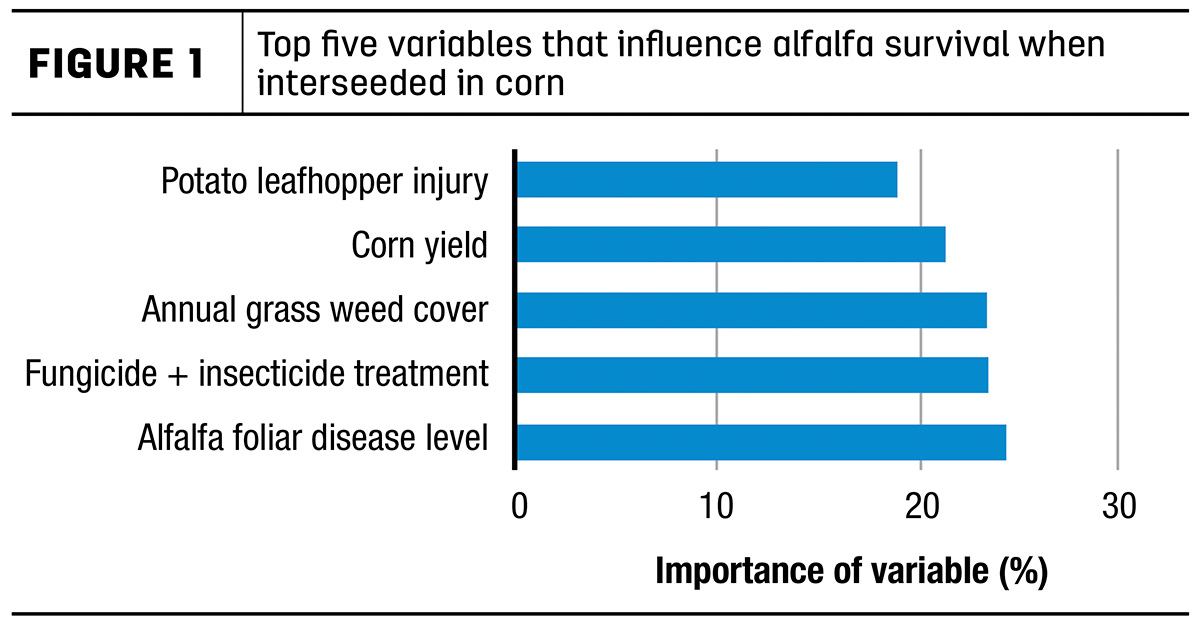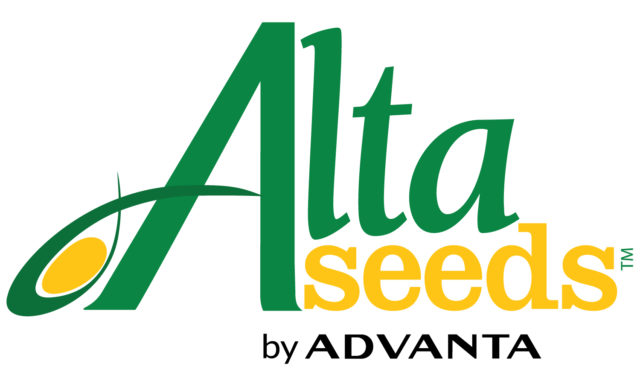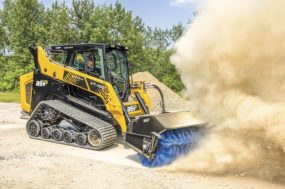Alfalfa producers know that any road to profitability starts with good alfalfa stand establishment. Many decisions and strategies exist for establishment, including variety selection, time of seeding, to use a companion crop or not, and conventional tillage or no-till. An alfalfa establishment method gaining some interest is interseeding alfalfa into corn for silage. The reason for this somewhat “out of the box” idea is to attempt to establish alfalfa a full year earlier than a conventional crop rotation would allow.
In the Upper Midwest with most corn silage/alfalfa rotations, corn silage is harvested in the fall with alfalfa planned to be planted the following spring. A spring direct-seeded alfalfa field will generally be harvested two times during the establishment season. Corn grown as silage produces more forage than alfalfa, especially in the establishment year of alfalfa when yields are one-half that of subsequent full production years. Interseeding alfalfa into corn planted for corn silage allows a full season of alfalfa to be harvested the next year.
Research has demonstrated that interseeding alfalfa between rows of corn silage can result in high yields of corn silage and successful establishment of alfalfa. While no alfalfa is harvested during the establishment year under the corn silage, forage yield the following year matches that of a fully established alfalfa field. This approach bypasses the low-yielding establishment year of solo, direct-seeded alfalfa. Research results over the last several years indicated this approach provides 10% more forage over the two-year time frame and increases the profitability for farmers.
Interseeding alfalfa into corn silage is not a new system, as farmers have been attempting to make this a successful system since the 1950s. Past research and literature revealed many of the same challenges and successes farmers face today trying to make this system work. A few benefits to this system are increased first-year alfalfa yield compared to conventional spring-seeded alfalfa, greater overall forage production from the combined corn silage and alfalfa rotations, profitability of corn silage-alfalfa rotations increased by 7% to 15% under average production conditions, and soil and nutrient loss from cropland decreased by 37% to 87% due to greater soil cover provided by interseeded alfalfa.
Of course, any new or different alfalfa establishment method or practice comes with a set of challenges. Farmers planning to try or adopt the alfalfa/corn silage interseeding method need to be prepared for a few nuances to the system. Figure 1 illustrates the top variables influencing alfalfa survival in the system.

Competition from interseeded alfalfa seedlings can reduce corn silage yield by 0% to 15%. Corn silage harvest under wet soil conditions can damage alfalfa stands. This can be the biggest challenge, as corn silage quality hinges heavily on harvest timing and whole-plant moisture. A final challenge is: An extra one to two passes may be required for agrichemical application to ensure establishment of alfalfa.
So to reduce the risk of alfalfa establishment failure or realizing a yield reduction in corn silage, some production practices should be followed. Soil fertility can be challenging when targeting one crop; this system ups the ante to manage soils for two crops. Alfalfa is the most sensitive crop when it comes to soil pH. At establishment, soil pH needs to be at a minimum of 6.6; 6.8 would be ideal. Soil potassium levels should be around 120 to 150 parts per million (ppm) at alfalfa establishment. Corn silage and alfalfa demand high amounts of potassium, so keep the soil potassium levels in the optimum range.
Successful corn silage soil fertility should be based on soil test results and application of phosphorus, potassium, boron and sulfur. To meet the nutrient needs of both corn silage and seeding-year alfalfa, apply up to 40% of nitrogen in starter fertilizer in 2-by-2 placement along the corn row. Deep banded fertilizer or manure under the corn row might be a good alternative. Total nitrogen rate from fertilizer and manure should be at the upper end of extension recommendations for corn silage. Alfalfa seeding rates are recommended to be around 16 pounds per acre of pure live seed. To achieve a good balance between alfalfa establishment and corn silage yields, plant corn to provide a final population of 26,000 to 32,000 plants per acre. Use lower corn populations until a comfort level of experience is gained with this production system.
Corn hybrid selection may also have to change when adopting the interseeding system. It is recommended to use an early to midseason hybrid for an anticipated earlier harvest to allow interseeded alfalfa adequate time to prepare for winter. Alfalfa varieties vary considerably in performance within this system. Plant a variety that is documented to be effective, such as those with high resistance to aphanomyces races common in the area. University of Wisconsin (UW) – Madison research has documented low-lignin or "high-quality" alfalfa varieties have not performed well in this system.
Setting up success of the two crops will also rely on planting timing of the two crops. In conventional systems, both crops benefit from early planting. Corn silage and grain yields are generally higher when planted early. The alfalfa/corn silage interseeding system creates a few minor changes to a conventional planting system. Alfalfa may get the emergence jump on corn and outcompete corn in cool soils. If corn is planted early under cool conditions where soil temperatures are below 50ºF, it is recommended to delay interseeding alfalfa until the corn V1 stage to lessen competition from alfalfa. If corn planting is delayed and warmer conditions favor growth of late-planted corn, alfalfa should be interseeded within three days to allow sufficient growth before corn canopy closure.
The interseeding system relies on timely planting of both crops. In general, the corn crop is planted first and alfalfa planted immediately after or within a few days. A drill with press wheels should be used to plant alfalfa at a quarter-to-half-inch depth in the corn interrow area. Row spacing for alfalfa should not exceed 10 inches – and if using a corrugated roller-seeder, ensure alfalfa seed is properly worked into soil just before or after corn planting.
Just as in any system, good integrated pest management is key to the system. Weed management may include a pre-emergence herbicide such as acetochlor after corn planting and just after alfalfa emergence. For glyphosate systems, it is highly effective when weeds are 4 to 6 inches tall. In conventional alfalfa or corn, bromoxynil applied when broadleaf weeds are 1 to 2 inches tall and after alfalfa has four trifoliate leaves is recommended. Pendimethalin can be applied if alfalfa has at least two trifoliate leaves and is less than 6 inches tall.
Plant health promoting agrichemicals such as prohexadione calcium on 4- to 12-inch-tall alfalfa often enhances alfalfa root growth and plant survival. In humid environments or especially during wet growing seasons, application of foliar fungicide on alfalfa near the V12 growth stage of corn is required for good alfalfa establishment. Insecticide can be beneficial if leafhopper pressure is above established thresholds.
References omitted but are available upon request. Click here to email an editor.










